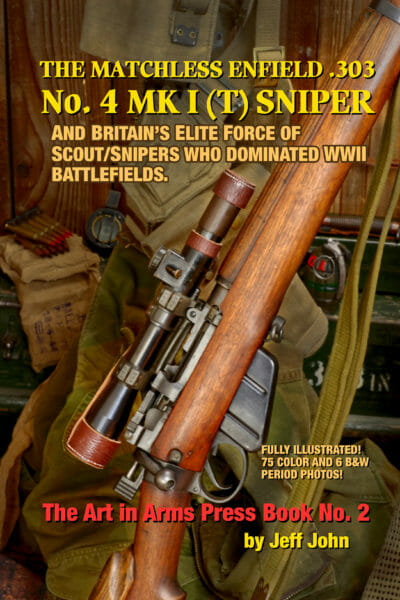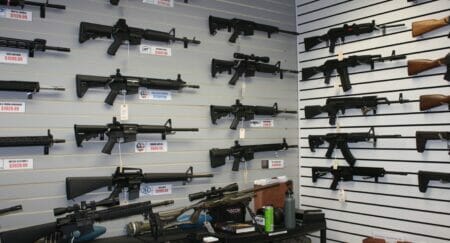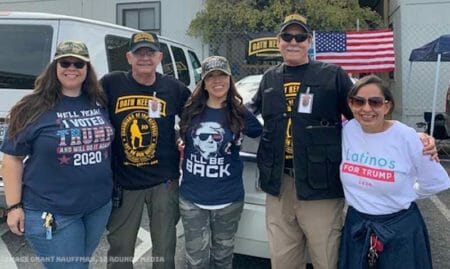
U.S.A. – -(Ammoland.com)- “HOW ON EARTH do you accidentally create the finest sniper rifle of WWII?” author, photographer and contemporary/historic firearms authority of note Jeff John asks. “The British did with the adoption of the No. 4 Mk I (T), the official designation of the telescopic-sighted No. 4 infantry rifle. It is arguably the most well thought out, rugged, durable and accurate of all the war’s sniper rifles.”
That’s from the opening chapter of “THE MATCHLESS ENFIELD No. 4 (T) SNIPER,” part of a sample preview John is offering to readers on his Art in Arms Press website. The book tells the story of how the No. 4 rifle was developed and used, and is illustrated with plenty of unique photographs (75 in color and six black and white period photos). It also “[i]ncludes handloading tips, factory ammo performance, a resource guide and bibliography.”
This is actually the second book by John I’ve brought to the attention of AmmoLand Shooting Sports News readers. In August of last year, this site posted “‘FG42’ Profiles Revolutionary, Near-Forgotten Classic in Words and Pictures,” highlighting the innovative technological breakthrough of a unique and superior German battle rifle that somehow “was lost on post-war arms designers who ignored its valuable lessons.”
Then a year ago, I told readers of my The War on Guns: Notes from the Resistance blog about John’s “Colours of the Queen’s Rangers,” an exclusive in words and pictures about the “the oldest known military colours in North America” and the unit that “never lost a battle during the American Revolution until the surrender at Yorktown.”
Before proceeding, I have a disclosure to make: I’m biased, and not just about having a favorable disposition toward the subject matter. I personally owe Jeff a lot. He’s not only the guy who first got me started writing for firearm magazines back in 1999 when he was an editor at Guns and Ammo, but he let me follow him over to his next gig at Handguns, and then for another 15 years at GUNS Magazine. He always gave me a lot of trust and free rein, and it’s safe to say I probably wouldn’t be writing here or at Firearms News had he not mentored and then supported and encouraged me.
That said, longtime readers know how I roll on saying what I believe. I say the guy’s work is superb and if my admission of personal loyalty is a showstopper for you, so be it. Somebody not exploring John’s work because of that will not be my loss.
If you’re OK with that, I suggest setting some time aside to tour the Art in Arms galleries, featuring “historical and contemporary firearm stories and photography.” The former category highlights “firearm photography from the Revolutionary War to modern times. Then there are galleries for the Old West and Napoleonic War, WW II, the Cold War and modern arms of interest.” In the latter category, “Modern firearms of the 20th and 21st century abound here.”
I can’t help but juxtapose that against some idiot gun-grabbing Democrat (and increasingly, “moderate” Republiquisling) politician railing to the media and spooking the herd about “civilians” having “weapons of war!!!”
“They all started out as ‘weapons war,’ you lying dumb@$$!” I’d love to hear somebody within microphone range yell back. Having “every other terrible implement of the soldier” is what the Founders intended “the people” to keep and bear. Even the rigged Miller opinion admitted the plan was for their arms to have “some reasonable relationship to the preservation or efficiency of a well-regulated militia [or] that this weapon is any part of the ordinary military equipment, or that its use could contribute to the common defense.”
The weapons that were “in common use at the time” were precisely the arms the military had, that is, what was in common use by the infantry. Considering that many Patriots were equipped with rifles and the standard-issue British long arm was a musket, in those cases, “the authorities” were even “outgunned.” We simply cannot ignore that the militia, at the time the Second Amendment was ratified, kept the same types of weapons at home as they were likely to encounter when called forth – otherwise, they would be marching off to their slaughter. That’s hardly an outcome that would be “necessary to the security of a free State.”
But I digress. Let’s go back to Jeff John’s featured “weapons of war,” and you can start over at Art in Arms Press. I hope you appreciate the site and share the link with like-minded friends.
If the sample chapters for “The Matchless Enfield” whet your appetite for more, you can order a copy for yourself from Amazon in Kindle or paperback (along with a copy of “FG42”).
About David Codrea:
David Codrea is the winner of multiple journalist awards for investigating/defending the RKBA and a long-time gun owner rights advocate who defiantly challenges the folly of citizen disarmament. He blogs at “The War on Guns: Notes from the Resistance,” is a regularly featured contributor to Firearms News, and posts on Twitter: @dcodrea and Facebook.






Am I the only one that looked at the cover image, then at any rifle in their safe and went “odd, why is that scope mounted backwards”?
Thanks for the post David. Too bad that most folks in England can`t own one of these Enfields that helped save them from the Nazis during the war.
The Minutemen were unorganized militia, not approved or chartered by the King, Governor or even a General. Today we are told the National Guard is the Militia. It isn’t. Some states still maintain a Militia, most stopped 100 years ago. But the Second Amendment is about protecting the right and the duty of the people to be able to control the government and prevent tyranny. Should a tyranny raise its ugly head and Congress does nothing, the people can form a Minutemen again. That’s what Patrick Henry demanded and why we have the Second Amendment. It was a common fear,… Read more »
I have an Enfield 1918 SMLE MKIII* that I restored from a barreled action I got in trade for $75 of 9mm.ammo from a Myrtle Beach Police Officer a couple years ago. He got it from the previous owner who had desecrated it by sporterizing it and he did not want the sporter stock. Original stock whereabouts unknown. I spent about $400 buying new old stock for furniture and metal parts from Liberty Tree Collectors and Sarco, Inc. NO reproduction parts. All original period correct from various rifles of the period. Buttstock is from an Indian Enfield training rifle. Handguard… Read more »
Bookmarked “Art in Arms” for further interest.
I was still reading “Guns and Ammo” when Jeff John was editor
The convincing word in the 2A is militia. That tells me it is about military gear. As far as I am concerned everyone who is of legal age, not in jail or the loony farm is part of the militia and should be and has every right to be and is ordered by their nation to be armed with up to and including the latest military armaments. I was issued a M-16 a-1 as a standard weapon but I qualified with several hundred types of military arms both foreign and domestic. I am a pilot so I would not pass… Read more »